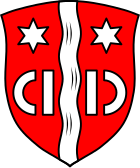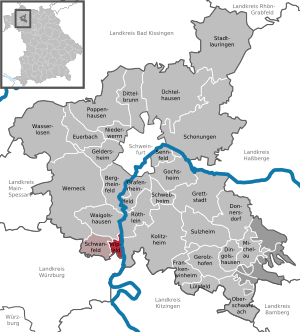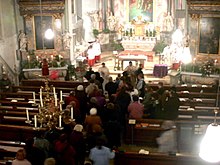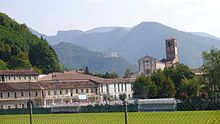Wipfeld
| coat of arms | Germany map | |
|---|---|---|

|
Coordinates: 49 ° 55 ' N , 10 ° 11' E |
|
| Basic data | ||
| State : | Bavaria | |
| Administrative region : | Lower Franconia | |
| County : | Schweinfurt | |
| Management Community : | Swan field | |
| Height : | 201 m above sea level NHN | |
| Area : | 5.23 km 2 | |
| Residents: | 1038 (Dec. 31, 2019) | |
| Population density : | 199 inhabitants per km 2 | |
| Postcodes : | 97537, 97509 | |
| Area code : | 09384 | |
| License plate : | SW , GEO | |
| Community key : | 09 6 78 196 | |
| LOCODE : | DE WPF | |
| Community structure: | 2 districts | |
| Address of the municipal administration: |
Marktplatz 1 97537 Wipfeld |
|
| Website : | ||
| Mayor : | Tobias Blesch ( CSU / Independent Voters) | |
| Location of the municipality of Wipfeld in the district of Schweinfurt | ||
Wipfeld is a municipality in the Lower Franconian district of Schweinfurt and a member of the Schwanfeld administrative community . Wipfeld is a wine village in the Franconian wine-growing region .
geography
Geographical location
Wipfeld is located in the Obereisenheim-Wipfelder Main Valley to the right of the Main at river kilometer 317.2 at the southeast end of the Schweinfurt district . The highest point is the Speiersberg at 315 meters. The district of the place is 521 hectares, of which 85 hectares are planted with vines.
The two larger cities of Schweinfurt (15 km) and Würzburg (27 km) are in the vicinity . After Werneck and Volkach is 10 and after Gerolzhofen 15 km.
Neighboring communities
Neighboring communities are (starting from the north clockwise): Waigolshausen , Röthlein , Kolitzheim , Eisenheim and Schwanfeld .
Community structure
Wipfeld is divided into two districts:
- St. Ludwig
- Wipfeld
The district of St. Ludwig is located on the left bank of the Main and can be reached with the Main ferry . There are five sulfur healing springs that were discovered around 1800. They formed the basis for the Ludwigsbad spa from 1811 to 1901. After that, the Benedictine monastery was expanded and a grammar school was set up. Today the Antonia-Werr-Zentrum is located there, a remedial youth welfare facility for girls and young women run by the Congregation of the Servants of the Holy Childhood of Jesus from the Third Order of St. Francis in Oberzell. Down the Main is the district of Schloss Klingenberg .
history
Wipfeld was first mentioned in a document on April 21, 918, when the Freising Bishop Dracholf donated the place to the Schwarzach monastery. The origin of the name is unclear; The personal name Wipo or Wippo is used as a defining word . Since the end of the 14th century, a cent court had its seat in town. In 1737 the community was granted market rights. The discovery of five healing springs on the left bank of the Main at the end of the 18th century led to the construction of the Ludwigsbad, which was expanded into the St. Ludwig monastery after being sold to the Benedictines in 1901. With Conrad Celtis and Eulogius Schneider , two prominent personalities came from this small wine village. From 1987 to 1995 Wipfeld was a model community for urban development and village renewal as well as a model project for the research area urban renewal of villages and districts of experimental housing and urban development at the Federal Ministry for Regional Planning, Building and Urban Development. The beautiful town center with numerous historical buildings can be explored along the Celtis circular route.
Important dates in the recent past were:
- 1938–1952 construction of lock and barrage
- 1956 New school building on the Kirchberg
- 1957 Construction of the water supply
- 1963 Servants of the holy childhood of Jesus acquire St. Ludwig's monastery
- 1965 Start of land consolidation
- 1969 Beginning of the relocation of the vineyards to the Wipfelder Zehntgraf location
- 1973 Construction of the pressing station
- 1980 Wipfeld and Schwanfeld found an administrative association
- 1980 Wipfeld receives a municipal coat of arms
- 1980 Commissioning of the sewage treatment plant (Zweckverband Stammheimer Group)
- 1984 British armed forces fighter plane crashes near Wipfeld
- 1986 Commissioning of a new motor vehicle ferry
- 1987 Wipfeld becomes a model community for urban village renewal
- 1996 The municipalities of Follina (Italy) and Wipfeld seal a municipal partnership
- 1997 Zehntgrafenweinweg and -laube as well as the Celtis-Rundweg are opened
- 2002 Wipfeld is the filming location for the TV show Young Wine and Old Songs
- 2003 Inauguration of the Antonia Werr Center after the renovation and expansion
- 2009 The literature house with literature museum is opened
Religions
The vast majority of the Wipfelder is Roman Catholic.
Population development

politics
mayor
Tobias Blesch (CSU / Independent Voters) has been mayor since May 1, 2014; he was re-elected on March 15, 2020 with a turnout of 70.4% with 84.3% of the votes.
Municipal council
In addition to the mayor, the municipal council has twelve members. In the election on March 15, 2020 , only the joint nomination of the CSU and independent voters was available, the twelve applicants with the most individual votes thus forming the municipal council for 2020 to 2026. In the 2014 to 2020 term of office, the CSU was represented with seven seats and the electoral group with five seats.
coat of arms
The coat of arms from 1978 is a silver wave pole in red with the silver capital letters CI in the mirror image. Above each is a six-pointed silver star. It was designed based on the poet's coat of arms of Conrad Celtis , who was born in Wipfeld .
Community partnerships
There is a parish partnership with the municipality of Follina in Italy . The place is in the Prosecco area between Valdobbiadene and Vittorio Veneto about halfway. Follina has a well-preserved medieval town center and a Cistercian monastery from the 14th century.
Culture and sights
Museums
- The Literaturhaus Wipfeld in the former Baderhaus contains an exhibition on the literary work of the sons of the community
Buildings
- The Catholic parish church of St. John the Baptist, whose nave was built in 1786/87, stands above the village. The choir was built in 1615. The tower dates from 1599 and is a Julius-Echter tower . The classical interior of the church comes from Materno Bossi .
- The monastery church of the Holy Family in St. Ludwig was built in the years 1906-09 and is furnished in the Beuron style .
- The former Würzburg official building with a stepped gable on the market square was built in 1580–1583 under Julius Echter von Mespelbrunn .
- The town hall with half-timbering , arbor and hipped roof was built in 1727.
- The rectory was probably built at the end of the 17th century and was built at the entrance to the parish church. The personal coat of arms of the Heidenfeld provost Albert Hoch was attached to the building.
Architectural monuments
societies
- The FC Wipfeld was established in 1921. The club's operations include football, netball and athletics.
- The Musikverein Wipfeld e. V. was founded in 1967 and is dedicated to maintaining local brass music.
- The Weinbauverein Wipfeld e. V. represents the interests of the local winegrowers and promotes wine tourism .
- The choral society Liederkranz Wipfeld e. V. is dedicated to singing.
Nature reserve
The Wipfelder Mainaue nature reserve near St. Ludwig extends over 72 hectares of meadowland on the left-hand Main River Main .
Regular events
Traditional wine festivals are the vineyard hike on Ascension Day, the promenade wine festival at the end of June and the street wine festival around the Assumption of Mary. The parish youth traditionally organizes an annual Midsummer bonfire.
Economy and Infrastructure
There is a branch of the Raiffeisenbank Volkacher Mainschleife - Wiesentheid in Wipfeld .
Viticulture
Today Wipfeld is an important wine-growing area in the Franconian wine-growing region . There is a vineyard around the village, the wine has been marketed under the name Wipfelder Zehntgraf since 1971. The name Zehntgraf results from the historically erroneous connection of the field name Zehntlein with the Zentgericht . Wipfeld is part of the range Volkacher Main loop until 2017, the wineries in area were Maindreieck summarized. The limestone soils around Wipfeld are also suitable for growing wine, as is the location in the Maingau climate zone, which is one of the warmest in Germany.
The people around Wipfeld have been involved in viticulture since the early Middle Ages . The Franconian settlers probably brought the vine to the Main in the 7th century. Viticulture was first mentioned in 1244. In the Middle Ages, the region was part of the largest contiguous wine-growing region in the Holy Roman Empire. The people mostly operated part-time viticulture for self-sufficiency , at the same time export centers were already emerging, especially along the Main. The Wipfelder offered their wines on the market in nearby Volkach .
Viticulture experienced a major decline after secularization at the beginning of the 19th century. Above all, locations with less favorable climatic conditions were completely abandoned. In addition, the emergence of pests such as phylloxera made cultivation difficult . The Franconian wine-growing region was not able to consolidate again until the second half of the 20th century. The use of fertilizers and improved cultivation methods had contributed to this, as had the organization in cooperatives and the land consolidation of the 1970s.
The wine culture today shapes the course of the year in the Maindorf. The 3.3 km long Zehntgrafen Wine Trail has been providing information about everything there is to know about wine since 1997 and attracts excursion tourists in particular. On the Kirchbergsteige is one of the oldest vineyards in Germany, which is still planted with the mixed set . In mid-August, the Wipfelder organize a street wine festival, and the wineries are open as hedge taverns during the spring and summer months . Mainly white wine varieties are developed in the companies.
| Vineyard | Size 1976 | Size 1993 | Size 2019 | Compass direction | Slope | Main grape varieties | Great location |
|---|---|---|---|---|---|---|---|
| Tithe count | 55 ha | 100 ha | 113 ha | south | 10-30% | Müller-Thurgau , Silvaner | Volkacher Kirchberg |
traffic
- The Main flows through the Wipfeld district. Bavaria's smallest inland port is located at river kilometer 317.
- The Main ferry connects Wipfeld with the St. Ludwig district.
- The Main cycle path leads through the community.
- The barrage with a hydroelectric power station and a ship lock are in the district. The power plant with two Kaplan turbines went into operation in 1951. With a drop height of 3.2 to 4.3 meters, the total output is 2900 kilowatts. Annual electricity generation corresponds to the needs of over 5700 average households. The operator of the system built by Rhein-Main-Donau AG is Uniper.
- The 1. Motoryachtclub Nürnberg e. V. maintains a sports boat harbor in Wipfeld at river kilometer 316.7.
education
- The Von-Pelkhoven-Schule in the Antonia-Werr-Zentrum is a school for educational assistance and learning support.
media
The official bulletin of the municipality is the Wipfeld gazette .
Sons and daughters of the church
- Conrad Celtis (1459–1508), German humanist and poet
- Eulogius Schneider (1756–1794), Franciscan (OFM) , Jacobin and religious philosopher
- Engelbert Klüpfel (1733–1811), important Catholic theology professor of the Enlightenment
- Nikolaus Müller (1758–1833), mayor and archetype of a manager
Others
The place has a functional local call system , which is used by the mayor to inform the citizens.
literature
- Hans Ambrosi, Bernhard Breuer: German Vinothek: Franconia. Guide to the vineyards, winegrowers and their kitchens . Herford 2 1993.
- Adelhard Kaspar : Grand Duke Ferdinand of Tuscany, sponsor of the mineral bath near Wipfeld. In: Franconian bathing trips in old and new times, Frankenbund, Würzburg 1965 p. 62f
Web links
- Official website of the municipality of Wipfeld
- Wipfeld inland port
- Entry on Wipfeld's coat of arms in the database of the House of Bavarian History
Individual evidence
- ↑ "Data 2" sheet, Statistical Report A1200C 202041 Population of the municipalities, districts and administrative districts 1st quarter 2020 (population based on the 2011 census) ( help ).
- ↑ http://www.bayerische-landesbibliothek-online.de/orte/ortssuche_action.html ? Anzeige=voll&modus=automat&tempus=+20111116/171939&attr=OBJ&val= 1779
- ^ Reitzenstein Wolf-Armin Frhr. von , Lexicon of Franconian place names. Origin and meaning. Upper Franconia, Middle Franconia, Lower Franconia. Munich 2009, p. 246.
- ↑ 2020 municipal council election , accessed on July 6, 2020
- ↑ http://www.literaturhaus-wipfeld.de/
- ^ Ambrosi, Hans (among others): German Vinothek: Franconia . Pp. 50-52.
- ^ Government of Lower Franconia: Vineyards in Bavaria broken down by area , PDF file, accessed on May 16, 2019.
- ^ Ambrosi, Hans (among others): German Vinothek: Franconia . P. 237.










